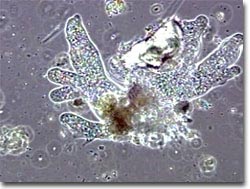

Even slime mould can work out the shortest route through a maze, scientists have found. They say the discovery shows that the most primitive amoeba-like organisms have some basic computing ability.Back to Protoctista References *** SUMMARY of Conclusions reached"This simple organism has the ability to find the minimum-length solution between two points in a labyrinth," says Toshiyuki Nakagaki of the Institute of Physical and Chemical Research in Nagoya, Japan.
Slime moulds are made of a mass of independent, amoeba-like cells that act as a single organism. To test their maze-solving ability, Nakagaki chopped up a slime mould called Physarum polycephalum. He then put each piece of mould in a different corridor of a maze he made by pushing plastic films into agar gel. At the entrance and exit of the maze, he placed blocks of agar filled with nutritious ground oat flakes.
Nakagaki found that the pieces of slime mould spread out and coalesced into a single organism. But as the mould continued to grow, he noticed it withdrew from dead ends in the maze and instead formed a thick tube linking the entrance and exit. Even though there were four possible routes between the start and end points, the slime always chose the shortest route, says Nakagaki.
"To maximise its foraging efficiency, and therefore its chances of survival," says Nakagaki, the organism "changes its shape in the maze to form one thick tube covering the shortest distance between the food sources."
Slime moulds such as P. polycephalum forage by rhythmically contracting and relaxing. But when they encounter food, the contraction frequency increases, which acts as a signal to attract more of the organism to the food source. When it finds two food sources, the organism benefits by forming a short link between them.